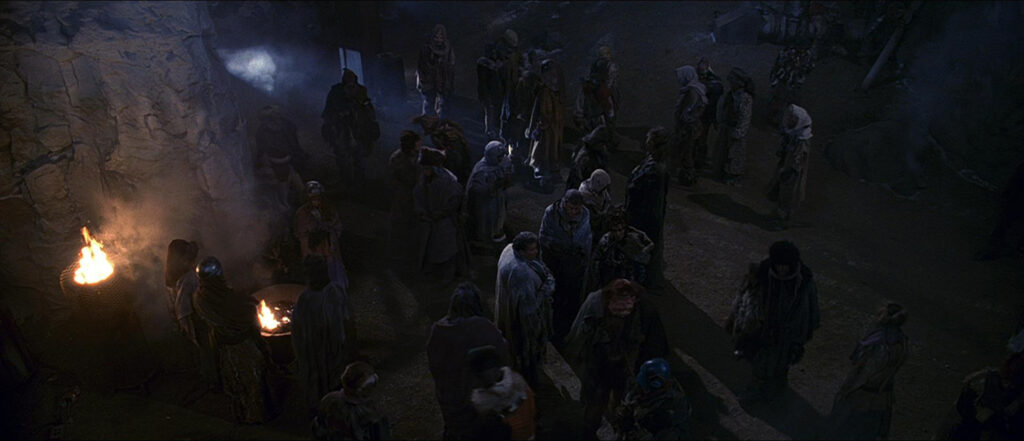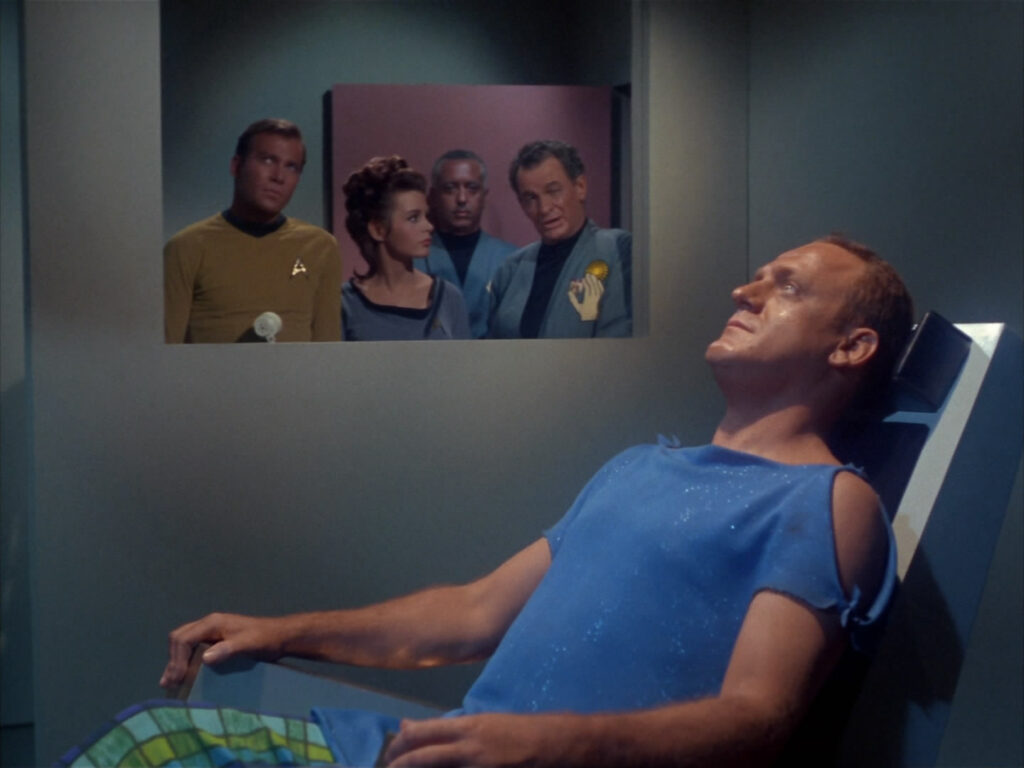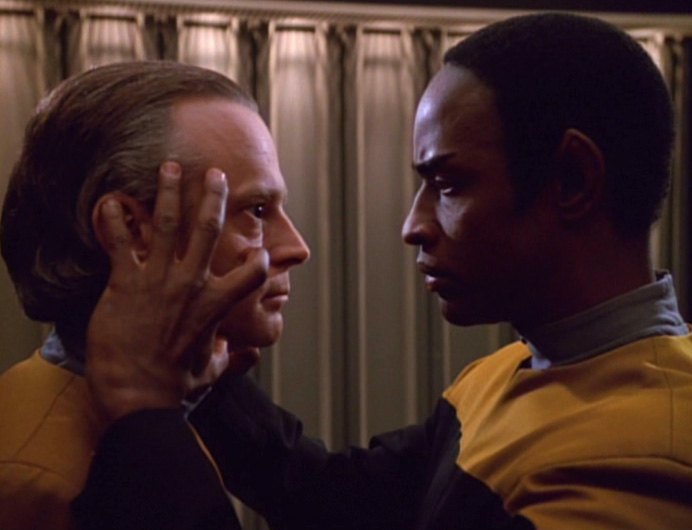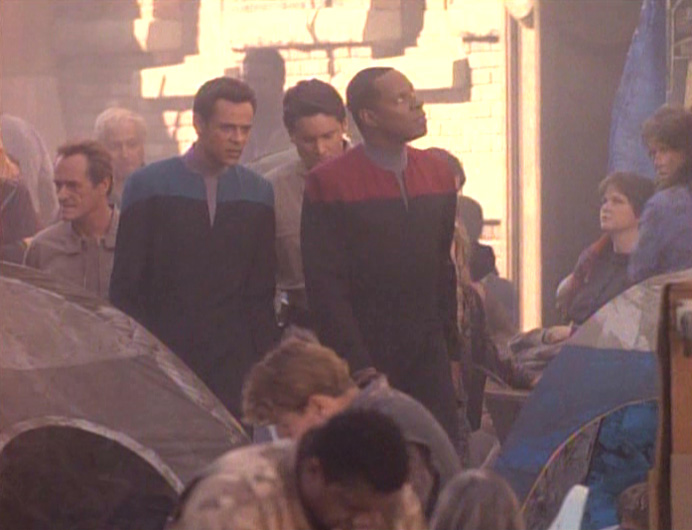For a show that presents such an optimistic vision of the future, there sure are a lot of penal colonies in Star Trek. Abolitionist Ruth Wilson Gilmore describes prisons as a “spatial solution to socio-economic problems” – that is, rather than addressing the underlying causes of crime, prisons allow us to simply relocate the problem. The presence of prisons in a future where most of the socio-economic issues that are criminalised in our century have already been made obsolete is testament to how deeply the idea of prisons is ingrained into society. Here’s a brief list of four times Starfleet crews have encountered different prison systems, and how those representations relate to the work of real-world prison abolitionists.
1. Rura Penthe (Star Trek VI; Enterprise: “Judgement”)

The most notorious penal colony in Star Trek may be the frigid dilithium-rich Klingon penal asteroid Rura Penthe. In both cases where Starflleet crew end up there, it is framed as a great miscarriage of justice: they have not truly done anything wrong and do not deserve to be there. Rura Penthe provides a way for the Klingon Empire to remove people who have become politically inconvenient, enabling the Empire to maintain a status quo of war and oppression.
In “Judgement,” Archer’s attorney, Kolos, bemoans the fact that the once-proud courts have become “a tool of the warrior caste.” Abolitionists, on the other hand, argue that the use of imprisonment to protect a dominant order is not a sign that the system is breaking down, but rather how it was designed to function. The abolitionist organisation Critical Resistance describes prisons as part of a larger system, the prison industrial complex, which “maintains the authority of people who get their power through racial, economic and other privileges.”
Imprisonment and over-policing disproportionately affect communities who have been marginalised through categories like race, disability, gender, sexuality, and class. Abolitionists contend that communities where there are high rates of imprisonment and police intervention are not made safer by those interventions, but rather are traumatised and destabilised by them, thus perpetuating their marginalisation. As Angela Davis writes, prisons are treated as “an abstract site into which undesirables are deposited, relieving us of the responsibility of thinking about the real issues afflicting those communities from which prisoners are drawn in such disproportionate numbers.”
Though the Enterprise crews’ experiences with Rura Penthe do not lead to any such reflections on the Federation’s own penal colonies, Rura Penthe demonstrates that the prison system may be a source of violence and injustice, rather than a solution to it.
2. Tantalus Penal Colony (TOS: “Dagger of the Mind”)

The Tantalus Penal Colony in “Dagger of the Mind” presents a different vision of a penal colony, one which has been reformed through medicalisation. Kirk describes prisons like Tantalus as “more like resort colonies” and “decent, clean hospitals for sick minds.”
While an inability to access proper health care, including mental health care, is doubtlessly a significant issue for many who become incarcerated, abolitionists caution against integrating such resources into the prison system itself. They distinguish between reforms which increase the reach of the prison system, and those which chip away at it. The aim is to stop using the prison system as a catch all for all social issues and actually address underlying problems in a way that puts power back in the hands of communities.
Many reforms may enable police and prisons to cause more harm by providing justification for more resources to be funnelled into the prison system – for instance, to pay for specialty training or technologies like body cameras. This concentration of resources creates an increasing reliance on police and prisons as the solution to social problems. In “Dagger of the Mind,” the expansion of the prison into psychology only ends up rendering prisoners more vulnerable to abuses of state power. As McCoy says to Kirk at the start of the episode: “a cage is a cage.”
Again, despite this insight, the Enterprise crew does not push for an end to imprisonment as a whole but simply removes the individual perpetrator. Prisons continue to exist within the Federation in various forms, often featuring punishments such as manual labour that draw criticism even in our own time, but go unquestioned in the Federation.
3. Mind meld therapy (Voyager: “Meld”, “Basics, Part I”)

Voyager’s “Meld” deals with one of the classic questions put to abolitionists – how would a humane society deal with dangerous people in the absence of prisons?
The character of Lon Suder, a Betazoid who murders a fellow crewmember, is essentially a serial killer, depicted as having deeply ingrained violent compulsions. In reality, most people in prison are not serial killers and police are not effective at catching and imprisoning serial killers. There are certainly people out there who have willfully harmed others, but to say we can’t deal with such people without prisons makes the questionable assumption that prisons actually do a good job of dealing with these people in the first place.
Perpetrators of violence often target members of marginalised communities, often the same communities targeted by police themselves. Even when abusers are caught, throwing one offender into prison does not offer solutions that make these communities any safer from future abuses. To say that the best we can hope for is to lock up a small number of perpetrators after the fact is to accept that we will always live in a world where the violence of white supremacy, misogyny, and queer/transphobia is normalised.
As Tuvok spirals into his own violent impulses, he becomes increasingly obsessed with punishing Suder, becoming himself a danger to the crew rather than working to help them heal from their traumatic loss. Abolitionists such as Beth E. Richie, argue that the best way to keep communities safe is to listen to those who are vulnerable to harm and strengthen them by providing support directly to those communities, rather than pouring resources into prisons and policing that may put them at further risk.
The absence of prisons in this instance provides an opportunity for the crew to reflect on the violence intertwined with many definitions of justice. Though their eventual solution is to confine Suder to his quarters, the inability to simply send him away allows for greater learning on Suder’s part as well as that of the crew.
4. Sanctuary Districts (Deep Space Nine: “Past Tense, Parts I & II”)

The Sanctuary District of 2024 San Francisco, portrayed in DS9’s “Past Tense,” is not technically a prison, and yet in practical terms it functions more like the prisons of today than perhaps any other system depicted.
Most people in the Sanctuary District are there simply because they lack resources, documentation, or are in need of medical care and support. Their confinement within the District allows the wealthy and privileged people outside the District walls to feel secure about their own place in society, blissfully free from having to actually think about the problems of those in the Sanctuary District. “It’s the only way to keep those people off the street,” says one of the cocktail-sipping elites Dax meets.
Sisko and Bashir eventually participate in a historic riot that eventually leads to the end of the District. This is only possible because they elevate the voices of those who have been confined, and reject the temptation for short-term gains and half-measures, insisting on total abolition of the Districts.
Abolishing the District is not just a matter of tearing down the walls and letting people run free into the same world that has denied them opportunities. Sisko insists on wider societal reforms that would structure the economy around the needs of the people, rather than vice versa. The goal of abolition is not just to eliminate prisons, but to make them obsolete. “I do know that someday there won’t be a need for places like this,” says Bashir.
The work of making prisons obsolete doesn’t just happen through broad legislative changes though. Everyday abolition happens whenever, as Miriam Kaba puts it, we work towards a society “built on cooperation instead of individualism, on mutual aid instead of self-preservation.” In the District we see small acts of kindness: sharing food and knowledge, giving medical aid. “The only help we’re going to get is from each other,” District resident Webb explains to Bashir. By building solidarity through mutual aid, the District residents prove to themselves that a better world is possible and that they can make it real. It is both the vision and the relationships built through this work that provide the social foundation for them to mobilise.
Conclusion
The persistence of prisons into the 24th century and beyond speaks to some of the core paradoxes of the Federation and Starfleet: organisations set up to explore and celebrate infinite diversity in infinite combinations, yet which evoke the violence of militarism and colonialism. Even while tearing down the District, Sisko and Bashir repeatedly contrast the plight of the District residents to that of actual prisoners, whose incarceration they believe to be justified. In other times and places, harsh prison sentences meted out to Tom Paris, Michael Burnham, and members of the Maquis reinforce an order grounded not in the needs of the communities or persons involved, but rather a centralised authority.
As Davis writes: “It has become so much a part of our lives that it requires a great feat of the imagination to envision life beyond the prison.” The fact that the existence of prisons continues to be taken for granted in what is generally a strikingly optimistic vision of humanity’s future is a reminder we can never be done imagining a future that is bolder and more empathetic than what has come before.
For a much more in-depth and nuanced discussion of prison abolition, she suggests diving into a reading list, like these ones by Abolitionist Futures and Freedom for Immigrants.
Roddenberry believed that all crime in the Federation would’ve been rooted out. But since that is unrealistic, I can see the need to dole out punishment with prisons. That said, I do applaud Star Trek showing that the prison system in the Federation HAS been reformed. The penal colony where Tom Paris was sentenced did, in fact, look like a resort. Sure, it’s still a prison but there had to be some punishment for what he did.
The only example I had a problem with was Eddington being in the brig for months while he waited for his court Martial in Deep Space Nine, but I guess I can chalk that up to not wanting to transfer a prisoner during wartime. In my head, prisoners waiting court martial are housed in Alcatraz which has been totally renovated so that prisoners no longer stay in cells–they’re housed in quarters. More of a college campus feel.
Why? The whole point of abolition is to move beyond “punishment” as the automatic default response to societal imperfections. And when you take into account that the Maquis had some very valid reasons to do what they did…
I think in the 24th century it’s about reforming criminals and punishing at the same time. Otherwise, you’re just telling people get away with crimes. as for the Maquis I do agree with you and if Eddington had resigned like Cal Hudson or Chakotay, that’d be one thing. But he used his position to break the law so he should at least be court martialed.